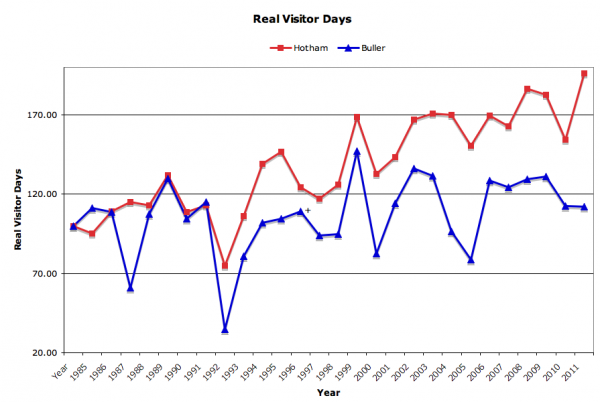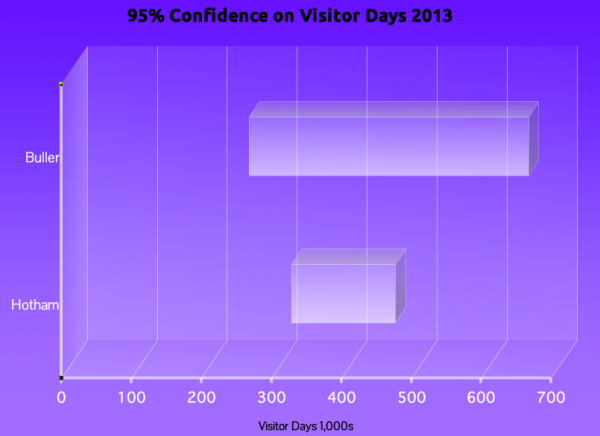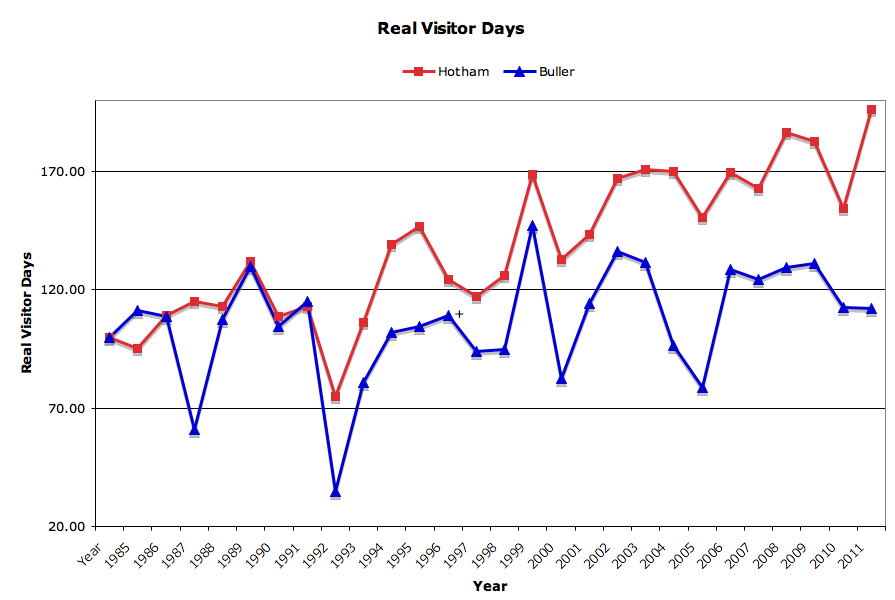With the season on it’s last legs, we can start to look at the post game performance of the Hero pass and Buller Season Pass, an area of hot discussion during the pre-season.
The most exciting thing is what the introduction of the HERO pass means for Hotham skiers, could great developments be in the near future?
Visitor Numbers to the resorts have been interesting this year. Despite the HERO pass, Buller still managed above average to get 476,421 visitor days, Hotham, hot on the heels had 447,294. Both are above average though Hotham achieved a new record. In evaluating the success of the Hotham HERO pass, we have to do a little work with the numbers.
Since 1985, Buller’s Visitor Days has been very variable, a low of 136,000 in 1993 to a high of 578,000 in 2000, Hotham contrasting with a low of 154,000 in 1993 to a high of 447,294. What’s far more interesting is when we start to look at averages and standard deviations.


Hotham, not surprisingly have experienced Visitor Day growth over the past 28 years with an annualised rate of 2.33%, Buller with a meer 0.47%. On top of that the average Visitor days for Buller is 419,700 versus 286,600 for Hotham. The standard deviation for both actually hovers closely, Buller 22.62% vs 23.59%. Though strip out the growth rates and relate it in Real terms, Hotham comes in at 10.20% vs Buller’s 21.77. Buller has substantially more wild swings than Hotham.
What does that all mean? What’s clear from these numbers is the Hotham has experienced sustained growth in numbers but also that it’s Visitor Days are less seasonally vulnerable than Mt Buller. As a result, Buller is more prone to higher variability of revenues; subject to the luck of the draw with higher highs and lower troughs.
In running a business, this poses many things to think about. Take for example farmers who experience different yields from their crops depending on the weather, they can struggle for years due to drought and then rebound with a few bumper years.
A while ago, the finance world came up with the idea of Futures. The farmer and the buyer would get together before planting and come to an agreement on price for their product. The farmer, knowing what they would receive, could then go out and buy themselves the seed and the equipment without the fear of not knowing if they would sell enough to cover their costs. One distinct advantage of this is that the bank is able to lend based on these contract, so the farmer doesn’t need to use their savings to go and purchase the seed.
Futures is a system that is suited for a business which experiences great variability with the revenues from year to year.
The irony of the ski industry is that what appears to have happened is that the businesses that experience the wild swings go to the spot market (waiting for day visitors to pay daily rates) whereas the businesses that don’t experience the variability have gone for the futures contracts (early bird season passes).
What’s the implications of this for skiers and boarders?
A company that experiences wild swings has to have a very robust war chest. They need to hold larger quantities of money to cover those years when margins are very thin and they make little profit. So whilst in a good year they will make lots of money, they will have to sock much of it away for leaner times instead of investing into development and infrastructure. For Bullerphiles I’m afraid that this means that you have to wait for those new chairlifts or snowmaking to appear.
For Hothamphiles, this is great news.
Hotham has been able to generate much more income this year, war chests can be leaner and hence this frees up more money for investment in development. There’s even a bigger issue at play here, on selling more Hotham HERO passes again this year for next season, they have locked in contracts. Whilst they don’t collect all the money from you now, they can take those contracts to the bank, borrow on them and then use that money for development. Take for example a chairlift that might cost $10million to build, take $6 million from this year and then borrow the other $4 million on future passes. So instead of having to wait for a new chairlift in 2014, you could potentially see one in 2013.
As a result of the HERO pass, expect to see great things come of Hotham. For Bullerphiles, keep praying to the snow god for good seasons.
So tell us, did you swap to Hotham this year and buy another HERO pass for next season? What improvements at your resort do you want to see come of this?
P.S. I don’t have any numbers for Perisher or Thredbo but if you’d like me to run them, please feel free to send them to us.
Nathan Gunn is the resident numbers man. His website is the place to go for all things budget and saving. If you have a topic you want him to explore, just send your suggestion to us.




